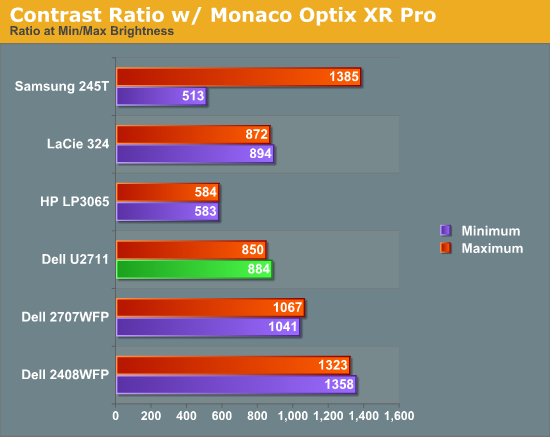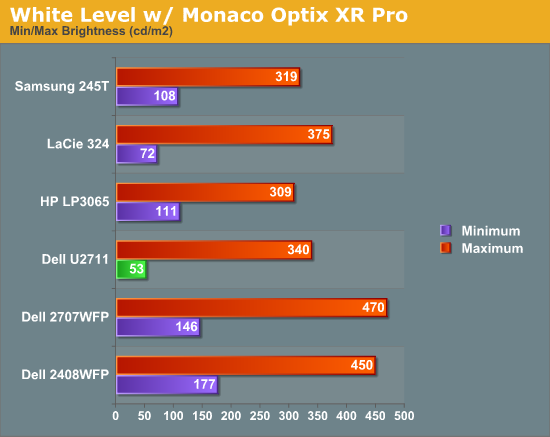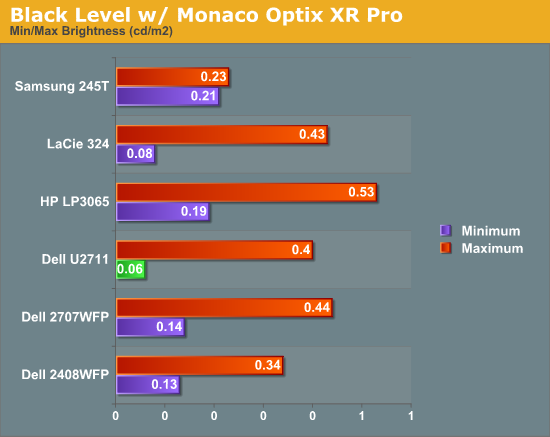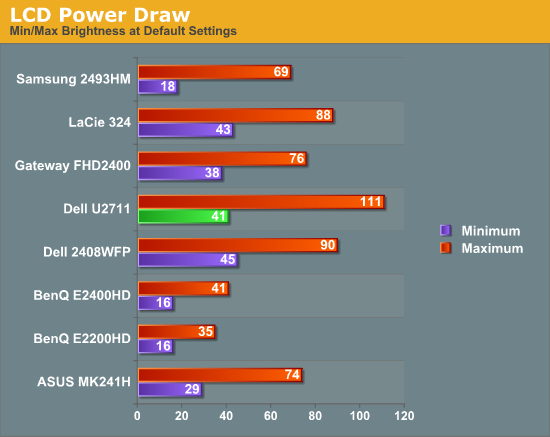Dell UltraSharp U2711: Quality has a Price
by Jarred Walton on January 22, 2010 2:00 AM EST- Posted in
- Displays
Brightness and Contrast
For the brightness, contrast, and color accuracy tests, we depend on a hardware colorimeter and software to help calibrate the displays. We use a Monaco Optix XR (DTP-94) colorimeter and Monaco Optix XR Pro software. Dell advertises a typical contrast ratio of 1000:1 and a maximum contrast (using dynamic backlight adjustment) of 80000:1. We're not interested in dynamic contrast, so we used the Adobe RGB setting for the results below. For those that are wondering, the reason we don't like dynamic contrast is that CCFL backlights take time to settle in and provide a consistent output, and if a display is constantly modifying the backlight level you won't get accurate colors.



Don't pay too much attention to the white/black graphs, as they are merely reference points for how the displays perform at certain settings. Like many other LCDs, the U2711 has a "normal" brightness level of around 260nits (the Adobe RBS setting defaults to 50% brightness and contrast), which is more than sufficient and is actually brighter than what most users prefer to use in an office environment. You can reach the advertised 350nits (give or take) if you max out brightness and contrast.
We're more interested in the contrast ratio, and here we find that the U2711 doesn't quite reach the advertised 1000:1 but instead comes closer to 850:1. We would have liked to see black levels a bit lower to improve the contrast, but really anywhere above 750:1 is difficult to see the difference, and 500:1 is sufficient for most users. At lower brightness settings, the contrast ratio improves to the point where our 100nits "print" result (~13% brightness) actually reached the advertised 1000:1 contrast ratio.
Power Requirements
Going along with the brightness levels, here are the power requirements we measured at the Windows desktop using the minimum brightness (53nits) setting along with 100nits (13%), 200nits (36%), and maximum brightness (340nits).

This is another area where we think the U2711 could be improved, but the cost might be too high right now. CCFL backlighting has been the norm since LCDs first came out, and it works but it's not the most power efficient way of lighting up an LCD. LEDs are the new and improved method, but while they can save power they also tend to deliver a lower color gamut. RGB LEDs address that shortcoming but they cost more and appear to use a similar amount of power compared to CCFL (and we've only seen them used in laptops so far). The U2711 draws a minimum of 41W, but a more realistic setting of 200nits will pull 72W. At maximum brightness the display settles down to 111W, but we measured a peak draw of 124W. (When we first cranked up brightness from 36% to 100%, brightness also reached 390nits before declining to 340nits.) We'd like to see LCDs that deliver all the color quality at half the power draw, but right now it's more a question of priorities: if you go green on power, your green colors may end up lacking. And to keep things in perspective, 72W at 200nits for a 27" LCD is still about half the power of your typical 21/22" CRT running at ~200nits!










153 Comments
View All Comments
Griswold - Sunday, January 24, 2010 - link
Go buy TN if you want to play games and are unaware of the _real_ benefits of IPS and PVA.darklight0tr - Friday, January 22, 2010 - link
Ugh...this is step backwards. 16:9 and an insane pixel pitch that is too small for most users.I owned the 2707WFP and currently use the 2709W because of the 16:10 aspect and high pixel pitch (1920x1200, 0.303). Because my eyesight isn't perfect it is a great LCD monitor for me, plus unlike the 28" TN based displays you could get a good quality S-PVA display with either one.
Now Dell has killed that option with this introduction. They took a step forward with the IPS display, but switching to a low pixel pitch 16:9 display sucks. I've used the 3007WFP and that pixel pitch would drive me nuts for normal use, most things are just too small despite the nice increase in real estate. Plus, doesn't this LCD strongly overlap with the existing 3008WFP?
Luckily I don't play on purchasing a new display anytime soon.
MadMan007 - Friday, January 22, 2010 - link
Also luckily for you this isn't meant as a direct replacement for the 27" monitors you have I don't think. It's a professional monitor with fancy color capabilities and electronics that aren't needed for general home and office use.darklight0tr - Saturday, January 23, 2010 - link
Given the fact that it shares the model number scheme with the previous monitors it is hard to know right now if it is a replacement for the 2709W. I guess we will know when the 2709W is phased out. If it gets a similar replacement (1920x1200 16:10) my previous comment is null and void.mczak - Friday, January 22, 2010 - link
"Note also that the HDMI connection uses the 1.3 standard, so it won't support resolutions above 2048x1152 (a 16:9 resolution)."That kinda sucks. Note that HDMI 1.3 definitely DOES support 2560x1600.
However, seems to be a useless paper spec. Some devices implement other features of hdmi 1.3 (like 30 bit color) however as far as I can tell there are neither monitors nor graphic cards which could output higher resolutions over (single-link) hdmi thanks to the possible higher link bandwidth. Even HD5xxx series graphic cards seem to be limited to 1920x1200, and for the monitors it's often impossible to even figure out as they just list "hdmi 1.3" but they don't tell you they actually don't support the higher bandwidth modes... And that spec is getting old already...
JarredWalton - Friday, January 22, 2010 - link
It could be my laptop that didn't support the appropriate resolution over HDMI, then.... let me test with the M6500 and see if that will do more than 2048x1152 on HDMI. I know that at least one laptop wouldn't allow anything higher. BIAB....Oops... the Dell M6500 doesn't have an HDMI port; just VGA and DisplayPort. If I could find my DVI to HDMI adapter I could try it on a different GPU; as it stands, all I know is that on the test laptop, HDMI limited the maximum resolution. (FWIW, I have a Dell Studio XPS where the DisplayPort tried to output 2560x1440 but the GPU apparently wasn't designed to do that. That same Studio XPS didn't give an option to try 2560x1440 on HDMI.)
Gnyff - Thursday, August 5, 2010 - link
I own the U2711 - and love it :-)I agree with mczak: The vendors are very bad at specifying what their HDMI does - even if they say 1.3 I'm not 100% sure they support the high bandwidth...
I'm very interested in real life experience with 2560*1440 over HDMI. I'm not certain that the U2711 actually supports it - and I've NEVER seen any of the notebook manufacturers specify maximum resolution over HDMI. But there's nothing in the specs preventing a well designed HDMI 1.3 notebook and screen to run at 2560*1440! Actually this /should/ be a certain thing if they both specify HDMI 1.3 (and at least Dell does!)...
However, the only safe for now bet seems to be Display Port - but they are mainly on the brand new notebooks and I HATE the glossy screens they usually come with. HP 8740W and Dell 6500 seems to be exceptions - but they are currently a bit outside the price range I was hoping for ;-)
Lord 666 - Friday, January 22, 2010 - link
If you are concerned about cost as I am, what about reviewing the 24" version or comparing along side? Don't understand why the review focused on a very large monitor that is a niche product.Mr Perfect - Friday, January 22, 2010 - link
Here's a professionally done review of the U2410, if that's the one you're looking for.http://www.tftcentral.co.uk/reviews/dell_u2410.htm">http://www.tftcentral.co.uk/reviews/dell_u2410.htm
JarredWalton - Friday, January 22, 2010 - link
Because it was offered as a review unit. LOL. I've been doing a lot of mobile reviews and it's hard to get in displays and laptop coverage from one person. This is why we have that call for writers that went out; I'm hopeful that I can turn all display reviews over to someone else and focus on just one area (more or less).